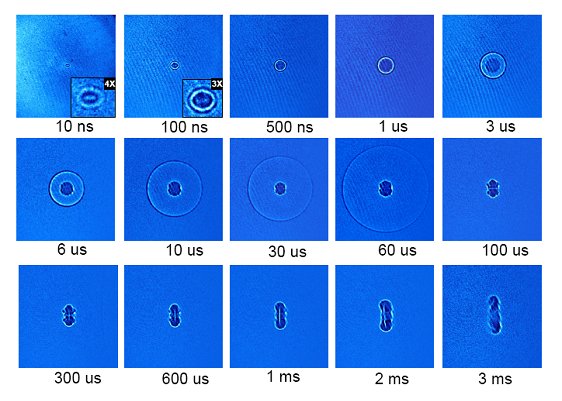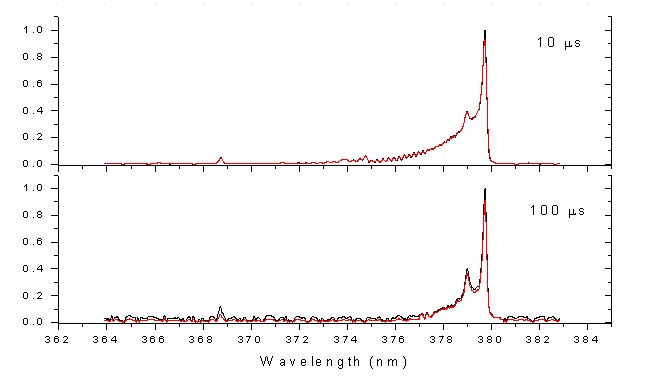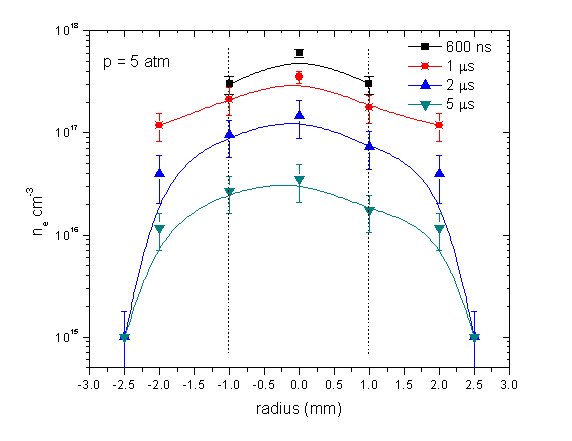Laser Induced Plasmas
In this research we have accomplished the measurements and analysis of laser-induced breakdown processes in air at a wavelength of 193 nm by focusing 200 mJ, 10 MW high power 193 nm UV ArF laser radiation on to a 30 um spot size. We examine pressures ranging from 40 Torr to 5 atm, that produce laser power densities up to 1 – 10 TW/cm2, well above the threshold power flux for air ionization. The breakdown threshold electric field is measured and compared with classical and quantum theoretical models. A universal scaling analysis of these results allows one to predict some aspects of high power microwave breakdown based on measured laser breakdown observations. Comparison of 193 nm laser induced breakdown data for air with calculations based on the collisional cascade and multi-photon breakdown theories are used successfully to determine the collisional microwave scaled portion with good agreement regarding both pressure dependence and breakdown threshold electric fields. Using a laser shadowgraphy diagnostic technique the plasma and shock wave dynamics are analyzed. Blast wave expansion of the plasma and laser heated neutral gas is observed with average velocities of 47 km/sec. Two-color laser interferometry is employed to measure time resolved spatial electron and neutral densities. The radiating species and the thermodynamic characteristics of the plasma are analyzed through optical emission spectroscopy (OES) supported by SPECAIR, a special OES program for air constituent plasmas. Rotational and vibrational temperatures are obtained from the emission spectra from the N2 C – B (2+) transitions by matching the experimental spectrum results with the SPECAIR simulation results. The plasma density decay measurements are compared with a simplified electron density decay model and obtained the dominant three- and two body-recombination terms with good correlation.
The air breakdown research is carried out as basic research with potential applications to high power laser and microwave breakdown, biological decontamination, radar cross section reduction, thin film processing and reduction of supersonic drag.
Facility
Below is a schematic and photo of the experimental and diagnostic setup of the 193 nm laser focus plasma.


Results
Universal Breakdown Curve

Universal plot of experimental 193 nm laser breakdown threshold fields (triangles) in air with 0.1 nm filter compared with microwave theory (solid line). Dotted line – microwave theory extended to 193 nm wavelength. Circles – MPI corrected breakdown threshold data, Squares – data in squares scaled by a factor of 1.51.
Shadowgraphy

Shadowgrams of the 193 nm laser focused plasma in air, with laser input radiation of 135 mJ energy. Each image has a spatial extent of 2.5 cm. Gating time for each image is 10 ns.
Two-Color Laser Interferometry

SPECAIR Code

Measured N2 (C–B) spectrum of the laser induced plasma; SPECAIR best-fit provides plasma temperatures.
Temperature

Rotational and Vibrational temperatures of the core plasma compared with the temperature behind the shock wave.
Density

Temporal electron density decay in dry air for 135 mJ laser pulse at different neutral pressures, 500 Torr, 1, 3 and 5 atmospheres.
Shock Wave Expansion

Temporal and Spatial evolution of the neutral density around the shock wave created by the laser focused plasma in air for 135 mJ laser pulse. A value of 2.45 × 1019 molecules/cc is used for atmospheric neutral density for air at 760 Torr.
Radial Density Measurement

Radial profile of electron density between 600 ns and 5 us at p = 5 atm. Region of Interest radius r = 1 mm.
Relevant Publications
- M. Thiyagarajan, J. E. Scharer. "Experimental Investigation of 193nm Laser Breakdown in Air," IEEE Plasma Sciences Special Issue on Pulsed Power. 37 manuscript pages, Accepted for Publication January 2008.
- M. Thiyagarajan, J. E. Scharer. "Experimental Investigation of Ultraviolet Laser Induced Plasma Density and Temperature Evolution in Air," Journal of Applied Physics, July 2008.
